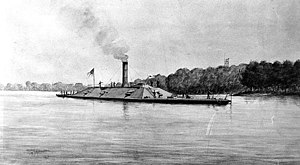USS Atlanta (1861)

A sepia wash drawing of CSS Atlanta by R.G. Skerrett
|
|
| History | |
|---|---|
|
|
|
| Name: | Fingal |
| Owner: | Hutcheson's West Highland Service |
| Builder: | J&G Thomson's Clyde Bank Iron Shipyard, Govan, Glasgow |
| Launched: | 9 May 1861 |
| Fate: | Sold, September 1861 |
| General characteristics | |
| Tonnage: | About 700 tons (bm) |
| Length: | 189 ft (57.6 m) |
| Beam: | 25 ft (7.6 m) |
| Draft: | 12 ft (3.7 m) |
| Depth of hold: | 15 ft (4.6 m) |
| Installed power: | 1 Tubular boiler |
| Propulsion: |
|
| Speed: | 13 knots (24 km/h; 15 mph) |
|
|
|
| Name: | CSS/USS Atlanta |
| Namesake: | Atlanta |
| Builder: | Asa and Nelson Tift, Savannah, Georgia |
| Acquired: | September 1861 |
| Commissioned: | 22 November 1862 |
| Decommissioned: | 21 June 1865 |
| Captured: | 17 June 1863, transferred to US Navy in February 1864 |
| Fate: | Sold to Haiti, 4 May 1869. Lost at sea, December 1869 |
| General characteristics | |
| Type: | Casemate ironclad |
| Displacement: | 1,006 long tons (1,022 t) |
| Length: | 204 ft (62.2 m) |
| Beam: | 41 ft (12.5 m) |
| Draft: | 15 ft 9 in (4.8 m) |
| Depth of hold: | 17 ft (5.2 m) |
| Speed: | 7–10 knots (13–19 km/h; 8.1–11.5 mph) |
| Complement: | 145 officers and men |
| Armament: |
|
| Armor: |
|
Atlanta was a casemate ironclad that served in the Confederate and Union Navies during the American Civil War. She was converted from a Scottish-built blockade runner named Fingal by the Confederacy after she made one run to Savannah, Georgia. After several failed attempts to attack Union blockaders, the ship was captured by two Union monitors in 1863 when she ran aground. Atlanta was floated off, repaired, and rearmed, serving in the Union Navy for the rest of the war. She spent most of her time deployed on the James River supporting Union forces there. The ship was decommissioned in 1865 and placed in reserve. Several years after the end of the war, Atlanta was sold to Haiti, but was lost at sea in December 1869 on her delivery voyage.
Fingal was designed and built as a merchantman by J&G Thomson's Clyde Bank Iron Shipyard at Govan in Glasgow, Scotland, and was completed early in 1861. She was described by Midshipman Dabney Scales, who served on the Atlanta before her battle with the monitors, as being a two-masted, iron-hulled ship 189 feet (57.6 m) long with a beam of 25 feet (7.6 m). She had a draft of 12 feet (3.7 m) and a depth of hold of 15 feet (4.6 m). He estimated her tonnage at around 700 tons bm. Fingal was equipped with two vertical single-cylinder direct-acting steam engines using steam generated by one flue-tubular boiler. The engines drove the ship at a top speed of around 13 knots (24 km/h; 15 mph). They had a bore of 39 inches (991 mm) and a stroke of 30 inches (762 mm).
...
Wikipedia
